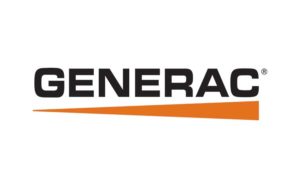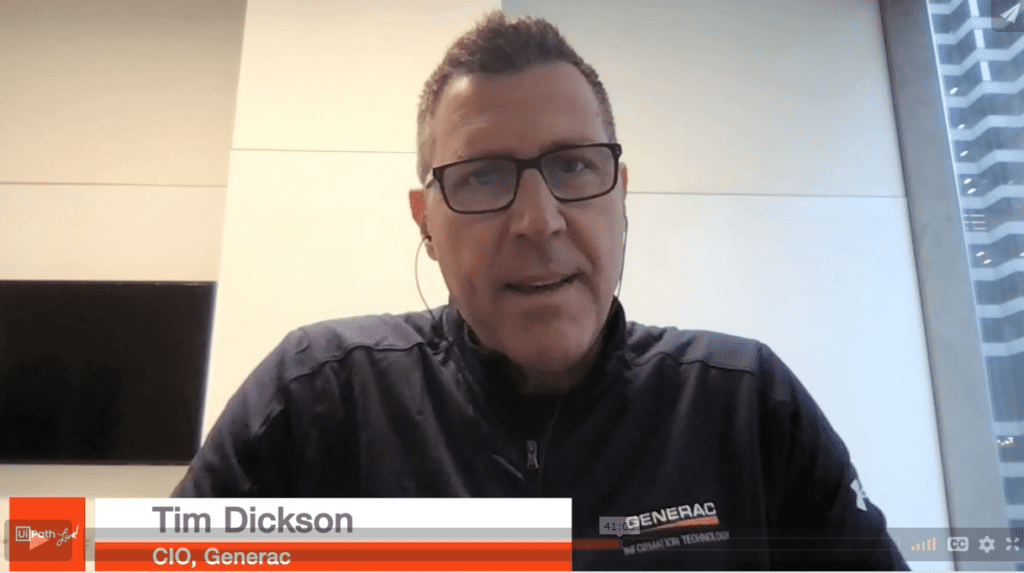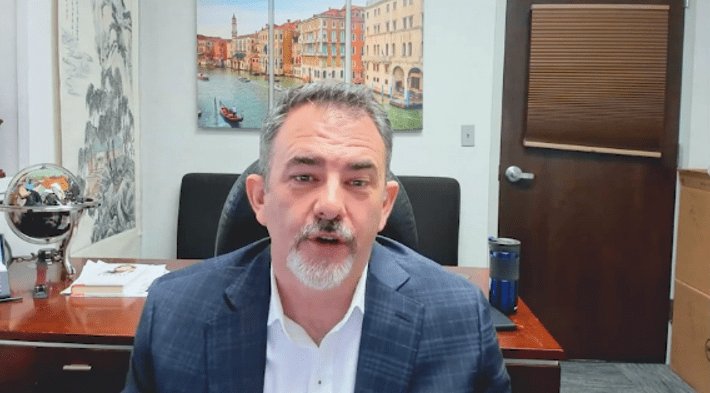
When Tim Dickson became the CIO of a fast-growing, multibillion-dollar manufacturer less than two years ago, he spotted a unique opportunity to place IT at the center of a corporate transformation, leveraging technology to enable the growth and scale that Generac is pursuing with vigor.
The key reasons for his excitement: He’d be reporting to the CEO; the company’s recent acquisitions showed it wasn’t afraid to take risks; and he had a great chance to help current employees enhance their skills while working with leading-edge technology.
The Digital Transformation of Generac
Generac is a manufacturer of motors, backup generators, and clean energy products based in Wisconsin with $3.74 billion in revenue in 2021.
Dickson and Generac are in the throes of a digital transformation powered by cloud technology. One prime example is the use of cloud-based automation software from UiPath (Dickson spoke at a recent UiPath Automation Cloud launch event).

As Dickson explains, he has been empowered by CEO Aaron Jagdfeld to leverage data, AI, and automation to digitally transform Generac, a 62-year-old company that is growing rapidly (50% revenue increase in 2021 and an expected 35% range this year). The transformation has been done through acquisitions that have placed the company in new lines of business including clean energy, solar, and renewables. “I liked that they were willing to take risks,” Dickson says.
“I joined to lead the digital transformation of the company from a manufacturing engine/backup generator company to a global energy tech solutions provider. Organizationally we’re scaling, and IT is enabling that growth and scale,” he says. “Using emerging technology to allow the business to grow and scale is what we’re all about.”
Dickson notes how cloud services are central to digital transformation initiatives, hence his focus on using the cloud to the maximum extent, including the cloud version of UiPath’s automation technology.

“Coming in as the digital transformation guy, there was no way I could have started off with any set of emerging technologies that were not using cloud.”
Generac CIO Tim Dickson
“Coming in as the digital transformation guy, there was no way I could have started off with any set of emerging technologies that were not using the cloud,” he says. “We were building all cloud and leveraging new emerging technologies in the cloud because that provided automation, scale, and security all at the same time.”
Cloud = Acceleration
The cloud also supports the need to operate at high velocity, a requirement in today’s Acceleration Economy. “I could not do anything that slowed down progress, lengthened the time to value, or anything that wouldn’t allow everyone to take advantage of the same tools, processes, and learnings,” Dickson says. “And all that was provided through cloud tools and the cloud option.”
In its product launch, UiPath noted that its cloud-based automation software is on a cadence of updates every two weeks versus twice a year for on-prem updates. That compressed cycle aligns nicely with the velocity that Dickson — and indeed all companies today — need. “The continuous cadence is needed to stay ahead,” says Param Kahlon, chief product officer at UiPath. “You have continuous enhancements and updates, and you don’t have to wonder how you’re going to get updated.”
Another accelerator: working directly for the CEO. According to Dickson, his reporting relationship is vital to his ability to drive digital transformation forward, giving him the profile and influence he needs to get things done: “The opportunity to work directly for the CEO and have IT elevated to a seat at the table and be part of senior leadership…you can’t drive digital transformation 2-3 layers below that level.”
| 5 Lessons for Digital Transformation Success |
| 1. Reporting to the CEO is critical |
| 2. Leveraging the cloud provides maximum automation, scale, security, and speed |
| 3. Be flexible in how you deploy people and consider upskilling those who are interested |
| 4. Centralized structure and common tools create a winning framework |
| 5. Automation projects create unique opportunities to partner with the business |
One of the major elements of Generac’s digital transformation was the use of automation, or bots, from UiPath. Dickson had been a customer before coming to Generac and was looking to automate a high number of manual processes. Today, the company has 15 UiPath bots in operation, automating functions within the front office, back office, and supply chain applications. “We’re experiencing a ton of benefits as a result,” Dickson says.
Kenny Mullican, CIO of Paragon Films and Acceleration Economy manufacturing cloud analyst, weighed in on where bots can improve supply chain efficiencies. He pointed to more efficient interactions resulting in higher customer and vendor satisfaction. “In supply chain and manufacturing, the quantities of scale mean that any small improvement in efficiency or decrease in cost can add up to significant impacts on profitability and improved relationships,” Mullican says.
With supply chain automation, “any small improvement in efficiency or decrease in cost can add up to significant impacts on profitability and improved relationships.”
Kenny Mullican, manufacturing CIO

New People vs. Upskilling
When Dickson joined Generac, he was new to its home base in Milwaukee, so he didn’t have a network of local technology talent to tap into for his automation initiatives. He made the decision to offer upskilling opportunities to current employees.
Many employees took the initiative to get certified and position themselves to develop automation skills, including development. “That was an awesome display of aspiration for people who aspire to do more for the company,” Dickson says. “As a CIO, my best day on the job is when I can see someone who was not skilled in something take advantage of upskilling and get moved into a new role that didn’t exist before and lead that effort as a result,” he says.
People and culture factors are particularly important when executing a digital transformation project, says CMO and Acceleration Economy analyst Scott Vaughan. For instance, a company may bring in digital-native talent from a small company and try to apply its skills in a large company, only to find that the talent becomes frustrated with the pace of a larger company. “The best-case scenario is when you can bring in specific talent to fill gaps and have these pros transfer knowledge and experience to others,” he says.

“The best-case scenario is when you can bring in specific talent to fill gaps and have these pros transfer knowledge and experience to others.”
Scott Vaughan, CMO
Dickson offered several pieces of advice to CXOs considering a move into automation:
- Avoid analysis paralysis: If you have manual processes that you think would benefit from automation, jump in and get started; there’s no need to over-analyze.
- Automation provides a great opportunity to partner with business stakeholders to uncover and streamline manual processes. “You can build better business relationships and deliver value.”
- Take full advantage of the technology by having all those involved operate in the same “hub” or tech platform so they can learn from each other.
Closing Thoughts
Dickson’s experience provides a framework for CXOs looking to transform their business. He recognized the need to have support at the highest levels of the company in order to drive change and new business models. Plus, he was entering the company at a time when it was already undergoing significant change, which paves the way for the types of technology advances he is looking to make.
His focus on using cloud-based emerging technologies, optimized by the human ingenuity of his people, positions Dickson well to pull off a successful digital transformation that underpins Generac’s corporate growth agenda. He’s in an enviable position with the latitude to leverage leading-edge tech and apply it to an already aggressive growth agenda to drive results.
Want to gain more insights from Cloud Wars Expo?
Starting on July 20th, more than 40 hours of on-demand cloud education content will be available for free to Acceleration Economy Subscribers.









